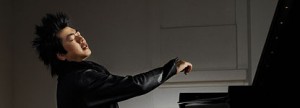On Saturday night, Gustavo Dudamel led the LA Phil in a concert featuring four works: Valses nobles et sentimentales by Ravel, the Piano Concerto No. 3 in C major, Op. 26, by Prokofiev with Lang Lang as soloist, the Sinfonía Burocratica ed’Amazzonica by Venezuelan composer Paul Desenne and La Valse by Ravel.
Dudamel began the program with Valses nobles et sentimentales by Ravel. These Schubertian-like waltzes (named after a set of waltzes for the piano by Schubert), originally written for piano by Ravel, befit their name, and the LA Phil performed them nostalgically but not overly so. Despite the large orchestra, Ravel never beats the listener over the head. And Dudamel provided a lilting interpretation that was a relaxing respite from the traffic jams on the freeways getting to the concert.
The first half concluded with the Prokofiev piano concerto. It is one of the premier showpieces of the piano repertoire and a perfect vehicle for Lang Lang who has a reputation for being showy. Well, he is still showy, but just enough to add more flare to his performance. His technique, however—Whew! Who knew fingers could fly so fast and not miss notes? In the coda of the finale, he was playing octaves so fast that his fingers were a blur.
Of course, the Prokofiev is also musically a masterpiece, and Dudamel and the orchestra made sure the music shone through, even though it was difficult not to allow the technical demands for the orchestra to overwhelm it. The sweet sounds of the clarinet, played with longing by Associate Principal Burt Hara, open the first movement with an Andante (marked dolce), but then only 10 bars later, the Allegro takes off like a jet and takes the listener (and the soloist) on a wild, soaring musical ride until the crashing C major end. Unfortunately, the audience did not bring Lang Lang out for enough curtain calls to get an encore out of him.
The second half of the concert began with Sinfonía Burocratica ed’Amazzonica. The composer described it as “a tropical chamber symphony” depicting the “clash of two opposite extremes of modern South American mythology: untamed wilderness and corrupt ‘civilization.’” The piece is largely percussive, with the woodwinds and a host of percussion instruments accompanied by the strings with distinctly Latin rhythms. Dudamel was obviously at home with this piece from his fellow countryman and showed his pleasure in conducting it.
Because of the chamber nature of the work, individual musicians were allowed to have a moment in the spotlight. Among the notables were bass clarinetist David Howard. Dudamel and the entire LA Phil took the audience on a brief musical excursion to South America for which the composer was thanked when he strode onstage to accept the audience’s warm reception.
Dudamel rounded out the program with another waltz by Ravel, La Valse, which is his darkly brooding version of the traditional waltz of 19th-century Vienna. The piece even begins darkly with the muted double basses playing softly but with hints of the tension to come. Dudamel allowed the frenzied aspects of the piece to have their full effect until the final fortissimo conclusion. And, unlike some other conductors, he followed the marking in the last two measures not to slow down, thus making it seem as if the audience, along with the orchestra, had just sprinted the final 100 yards of a race.
—Henry Schlinger, Culture Spot LA
For information about upcoming concerts, visit www.laphil.com.






